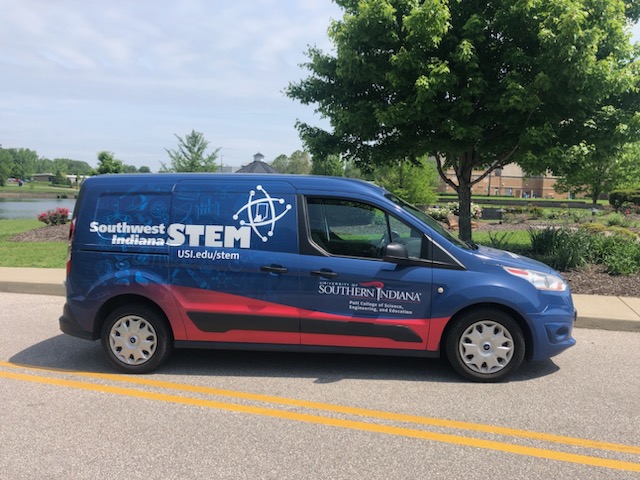
Looking for classroom activities that meet academic standards? A retired Middle School teacher, Tom Heckman, has been working with SwISTEM and has generously offered his treasure trove of teacher-tested activities! Most of the activities are geared to Middle School students, but they could easily be adapted for other grades. All the activities are easy to do and require minimal supplies.
Abiotic v. Biotic Factors: This worksheet helps students understand the difference between abiotic and biotic factors. This activity meets the 6th grade MS-LS2-4 standard.
Bouncing Ball: This mini-lab is perfect for introducing the concept of independent v. dependent variables. This activity could be used to meet the 3rd grade 3-PS2-2 standard.
Boyle's Law: This lab requires a large syringe for each group. It is a simple way to teach a topic that can be challenging! This activity meets the 5th grade 5-PS1-1 standard.
Calculator Robots: Did you know you can teach basic coding using a TI-84 calculator? Me neither. This fun activity requires only a TI-84 calculator. This activity can be used to meet Middle School Computer Science standard 6-8-PA.1.
Candy DNA: This is a tasty way to teach about the structure of DNA molecules. See the activity for the candy needed. This activity meets the 8th grade MS-LS3-1 standard.
Cell Organelle Riddles: These are a goofy but fun way to introduce the names of cell organelles. This activity can be used to help meet the 7th grade MS-LS1-1 and MS-LS1-2 standards.
Constellation Project: This activity walks students through creating a presentation on a constellation. It works well to spark interest in stars! This activity meets the 6th grade MS-ESS1-2 standard.
Crashed on the Moon: This worksheet activity is a fun way to talk about the moon or to introduce Newton's 1st law. Students can work independently or in a group. Or you can have the students do the worksheet first by themselves and then as a group-- it's a good way to subtly teach that we can learn from each other! This activity meets the 6th grade MS-ESS1-1 standard.
Create Your Own Adaptations: This activity combines art and science. Each group or student will need markers/ colored pencils and a set of dice. Students roll the dice to determine what adaptations their animal has. Fun and great way to introduce the concept of animal adaptations. If you are doing this activity with a younger group (elementary), this version is a bit easier: Easier Create Your Own Adaptations (you will still need the info from the original activity). This activity meets the 3rd grade 3-LS4-2 standard, the 4th grade 4-LS1-1 standard, and the 8th grade MS-LS1-4 standard.
Deer Predation or Starvation: A great worksheet activity that requires data interpretation as well as graphing. This activity meets the 6th grade MS-LS2-1 standard.
Dinner Photosynthesis: This clever activity introduces photosynthesis by letting students choose activities from a "menu" of choices. It teaches students about photosynthesis but allows them flexibility and creativity at the same time. This activity meets the 6th grade MS-LS1-6 standard.
Drawing Cells: This activity can be done outside with sidewalk chalk or inside with just pen/ pencil and paper. It is an interesting way to introduce the vocabulary associated with cells as well as test listening skills! This activity can be used to help meet the 7th grade MS-LS1-1 and MS-LS1-2 standards.
Loop Airplanes: Loop airplanes are easy to make and they are a fun way to meet engineering standards. You only need straws, paper, tape, scissors, and a meter stick for this activity. This activity meets the Middle School MS-ETS1-1, MS-ETS1-2, MS-ETS1-3 and MS-ETS1-4 standards. It could also be used for the Grades 3-5 ETS1-1, 3-5 ETS1-2, and 3-5 ETS 1-3 Engineering standards.
Magic Milk: This chemistry experiment is a perfect first day of school activity. It requires only milk, styrofoam bowls, and a few other supplies. Great for introducing the concepts of hydrophilic and hydrophobic. This activity meets the 8th grade MS-PS1-2 standard.
Oobleck: This fun activity can be paired with Dr. Seuss if so desired! It is great for launching a conversation about states of matter or viscosity. You will need cornstarch, beakers, and food coloring (beakers available from the lending service if needed). This activity meets the 8th grade MS-PS1-2 standard.
Pendulum Lab: This basic experiment requires paper clips and washers. It is a simple way to introduce the concepts of independent and dependent variables as well as hypothesis creation. This activity meets the Middle School MS-ETS1-1, MS-ETS1-2, MS-ETS1-3 and MS-ETS1-4 standards. It could also be used for the Grades 3-5 ETS1-1, 3-5 ETS1-2, and 3-5 ETS1-3 Engineering standards.
Plotting Volcanoes: For a deep dive into the world of volcanoes, this activity is perfect. Students have to interpret data, leading to discussions about hot spots and plate tectonics. This activity meets the 7th grade MS-ESS2-2 standard.
Sewer Maggots: This is an easy lab that explores the concept of density. You just need a bottle of Mt. Dew, raisins, and a beaker (which we can supply if needed).
Slime Day: If you have ever wanted to make slime, this is your resource! It includes directions for several types of slime as well as supply lists. This activity meets the 8th grade MS-PS1-2 standard.
Spinning a Food Web: Perfect way to demonstrate the food web in a hands-on way. You need nature magazines (or you could download pictures) and a large ball of string. You will also need a copy of the Spinning a Food Web Worksheet. Meets the 5th grade 5-LS2-1 Standard.
Volcano Powerpoint Presentation: This activity provides an outline for students presentations on a volcano of their choice. It also includes a list of volcanoes for them to choose! This activity meets the 7th grade MS-ESS2-2 standard.